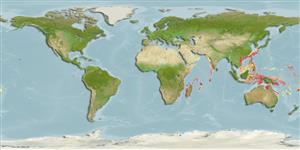Teleostei (teleosts) >
Anguilliformes (Eels and morays) >
Synaphobranchidae (Cutthroat eels) > Ilyophinae
Etymology: Dysomma: Greek, dys, dyo = two + Greek, omma = eye.
Environment: milieu / climate zone / depth range / distribution range
Ecology
Marine; demersal; depth range 100 - 175 m (Ref. 58018). Tropical
Indo-Pacific.
Size / Weight / Age
Maturity: Lm ? range ? - ? cm
Max length : 60.0 cm TL male/unsexed; (Ref. 106136)
Short description
Morphology | Morphometrics
Vertebrae: 128 - 133. This species is distinguished by the following characters: with pectoral fin; dorsal-fin origin anterior to level of pectoral fin base, predorsal length 10.0-12.9% TL; anus anterior, just below pectoral fin, preanal length 15.5-18.2% TL; very short trunk, its length 2.4-3.9% TL; intermaxillary teeth 2; compound teeth on vomer 3; upper jaw with 3 or 4 rows small sharp teeth; lower jaw with a single row of 2 large anterior teeth followed by 22-31 small sharp teeth; head pores: IO 4, SO 3, M 6, POP 0 (1 with 1), AD 1 (1with 0); lateral-line pores: predorsal 3-5, prepectoral 5-7, preanal 8-11, and total 65-78, the last at about anterior two-thirds of total length; MVF 8-13-130, total vertebrae 128-133 (1 with 120); colour of body light grayish to brown dorsally, paler ventrally; posterior half of anal-fin base deep brown, and dorsal and anal fins with white margins (Ref. 106136).
Life cycle and mating behavior
Maturity | Reproduction | Spawning | Eggs | Fecundity | Larvae
Smith, D.G., 1997. Synaphobranchidae. Cutthroat eels. p. 1658-1661. In K.E. Carpenter and V.H. Niem (eds.) FAO species identification guide for fishery purposes. The living marine resources of the WCP. Vol. 3. Batoid fishes, chimaeras and bony fishes part 1 (Elopidae to Linophrynidae). FAO, Rome. (Ref. 39639)
IUCN Red List Status (Ref. 130435)
Threat to humans
Harmless
Human uses
More information
Common namesSynonymsMetabolismPredatorsEcotoxicologyReproductionMaturitySpawningSpawning aggregationFecundityEggsEgg development
Age/SizeGrowthLength-weightLength-lengthLength-frequenciesMorphometricsMorphologyLarvaeLarval dynamicsRecruitmentAbundanceBRUVS
ReferencesAquacultureAquaculture profileStrainsGeneticsElectrophoresesHeritabilityDiseasesProcessingNutrientsMass conversion
Tools
Special reports
Download XML
Internet sources
Estimates based on models
Phylogenetic diversity index (Ref.
82804): PD
50 = 0.5001 [Uniqueness, from 0.5 = low to 2.0 = high].
Bayesian length-weight: a=0.00102 (0.00046 - 0.00225), b=3.06 (2.88 - 3.24), in cm total length, based on all LWR estimates for this body shape (Ref.
93245).
Trophic level (Ref.
69278): 4.0 ±0.4 se; based on size and trophs of closest relatives
Fishing Vulnerability (Ref.
59153): Moderate vulnerability (44 of 100).
